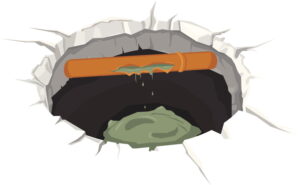Sewer backups are inconvenient and pose significant health and safety risks. Homeowners must understand what causes sewer backups, recognize the signs, and know how to prevent and address them. This guide will delve into these aspects to help you navigate sewer backup issues effectively and when to contact our plumbers in St. Petersburg, FL. This guide will delve into these aspects to help you navigate sewer backup issues effectively and when to contact our plumbers in St. Petersburg, FL.
What Happens During a Sewer Backup?
A sewer backup occurs when wastewater from your plumbing system cannot flow properly and backs up into your home. This can happen for various reasons, including blockage in sewer lines, tree root intrusion, aging pipes, or sewer system malfunctions.
When a backup occurs, wastewater can overflow from drains, toilets, and other plumbing fixtures, causing damage and creating unsanitary conditions.
How Do You Tell If There’s A Sewer Backup?
Several signs can indicate a sewer backup in your home:
- Several drains in your home are clogged simultaneously
- Foul odors emanating from drains or plumbing fixtures
- Persistent slow drainage in sinks, showers, or toilets, even after attempts to clear them
- Water backing up into sinks, tubs, or toilets
- Sudden sinkholes or depressions in your yard, particularly near sewer lines
What to Do If You Experience a Sewer Backup
If you suspect or experience a sewer backup in your home, take the following steps:
- Avoid using sinks, toilets, showers, or plumbing fixtures to prevent further backup and damage.
- Contact a licensed plumber immediately to assess the situation and perform necessary repairs.
- Take photos or videos of the backup and any resulting damage for insurance claims and documentation purposes.
- Once the backup is resolved, thoroughly clean and disinfect affected areas to prevent health hazards and mold growth.
How to Prevent Sewer Backups
While sewer backups can be challenging to predict entirely, there are preventive measures you can take to reduce the risk:
- Regular Maintenance: Schedule routine inspections and maintenance of your sewer lines and plumbing system to detect and address potential issues early. Learn about when to schedule sewer cleaning to keep your lines clear.
- Dispose of Grease Properly: Avoid pouring grease, fats, or oils down drains, as they can solidify and cause blockages in sewer lines.
- Use Drain Screens: Install drain screens or filters in sinks, showers, and tubs to catch hair, debris, and other materials contributing to clogs.
- Be Mindful of Flushing: Only flush toilet paper and human waste down toilets. Avoid flushing items like wipes, feminine hygiene products, or paper towels, which can cause blockages.
- Tree Root Management: If trees are near your sewer lines, consider professional root management to prevent roots from infiltrating and damaging pipes.
- Upgrade Aging Pipes: If your home has old or deteriorating sewer lines, consider upgrading to newer, more durable materials to reduce the risk of backups. For insight on replacing plumbing, see when to replace old plumbing fixtures.
By taking proactive steps to maintain your plumbing system, practicing responsible waste disposal habits, and investing in preventive measures, you can minimize the likelihood of sewer backups and protect your home from potential damage and health hazards.
Sewer backups can be disruptive and pose significant challenges for homeowners. Understanding the causes, recognizing the signs, knowing how to respond in case of a backup, and implementing preventive measures are essential for avoiding sewer backup issues. For additional help managing your plumbing, consider why a whole-house water filtration system may benefit your home.
Schedule a visit today with The Clean Plumbers. The one with the bubbles on the trucks.

